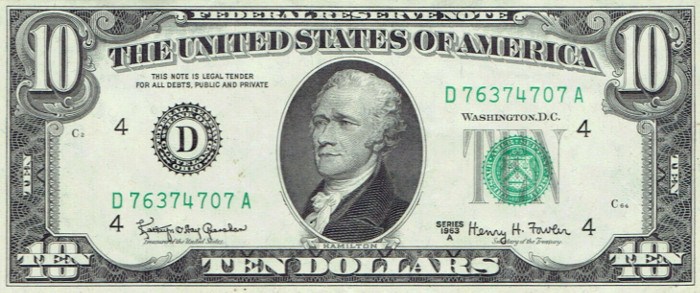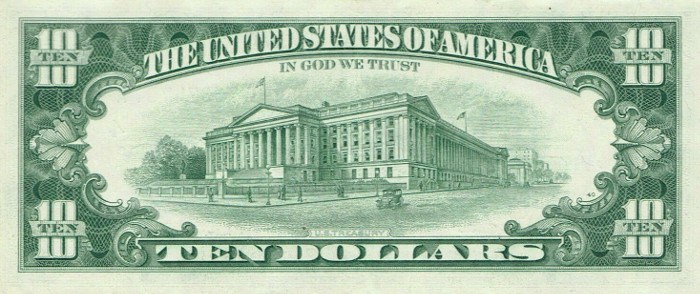The 1963 ten dollar bill is not a rare or valuable bill. Therefore most of these bills will not be worth much more than face value. However there are star note varieties that sell for more money. Continue reading to learn more about these bills.


Specifications
| Denomination: | $10.00 USD |
| Type: | Federal Reserve Note |
| Seal Varieties: | One: Green |
| Series Varieties: | Two: 1963, 1963A |
Value
Most of these bills in circulated condition will only be worth their face value of $10. Bills that are in extremely fine condition and up can sell for a premium. Star notes will also sell for a premium.
The 1963 series $10 bills are worth around $15 in extremely fine condition. In uncirculated condition the price is around $60 for bills with an MS 63 grade.
The 1963A series $10 bills are worth around $15 in extremely fine condition. In uncirculated condition the price is around $35 for bills with an MS 63 grade. Notes issued from the Federal Reserve Bank of Minneapolis will be worth more money.
Star Notes
Star notes are replacement bills that the United States Federal Reserve printed. These star notes are more rare and thus more valuable. You can tell if you have a star note by looking to see if there is a star symbol at the end of the serial number.
The 1963 series $10 star notes are worth around $37.50-70 in extremely fine condition. In uncirculated condition the price is around $100-125 for notes with an MS 63 grade.
The 1963A series $10 star notes are worth around $27.50-30 in extremely fine condition. In uncirculated condition the price is around $65-70 for notes with an MS 63 grade. Notes issued from the Federal Reserve Banks of St. Louis and Minneapolis will be worth more money.
Grading System
Extremely fine- A note that shows small signs of having been in circulation. The note will be bright and it will have almost all of its original crispness. There might be one or two minor creases or folds but there are no stains, discolorations, or tears.
MS 63 choice uncirculated- A note that shows no signs of ever having been in circulation. The note still has its original crispness. The note is also well-centered.
History of the 10 Dollar Bill
Every $10 bill features Alexander Hamilton on the front. Hamilton was never president but he did serve as the nation's first Secretary of the Treasury. Today every $10 bill is a Federal Reserve note, but in the past there were also legal tender notes, silver certificates and gold certificates. In addition, there were different sized bills. Every bill printed before 1928 was a large-size bill. The current small size bills were first issued for the 1928 series.
As far as value goes, generally the older bills will be more valuable- especially the older large-size notes. However the small-size notes can also be valuable if they are of a rare variety.
Conclusion
As mentioned, this isn't a very valuable bill. Other ten dollar bills are more valuable, including the prior 1934 ten dollar bill. But if you have a star note then your bill can be worth over $100.
Sources:
